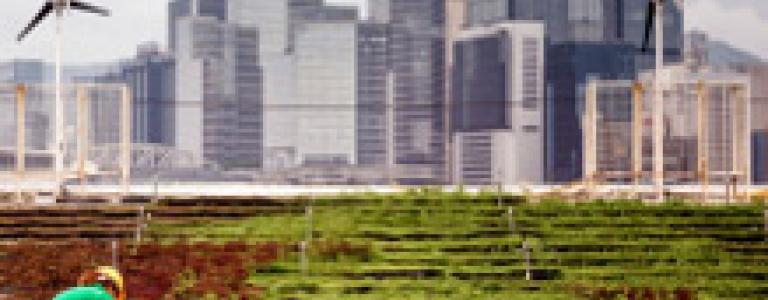China's Carrot and Stick Approach to Green Finance
These are big times for China. With the conclusion of the G20 meeting in Antalya, Turkey, China takes up the mantle as host of the next G20 summit.
Central to its offering is a newly-formed G20 Study Group on Green Finance, a first for that top-level forum. The several multilateral vehicles that China hosts or has initiated—the New Development Bank (formerly the BRICS Bank), the Asia Infrastructure Investment Bank, the Silk Road Fund, and the South-South Cooperation Fund—are all grinding into motion, further extending China’s reach as a key source of investment capital for development.
The framework for the 13th Five-Year Plan, recently released by the Communist Party of China, contains a strong chapter on green finance—another first—and inaugurates a range of green finance incentives aimed at accelerating the transition to cleaner forms of development. Though the Plan will only formally be adopted early next year, the direction it is taking is clear and is unlikely to change significantly. Indeed, in anticipation an Integrated Reform Plan for Promoting Ecological Progress has been issued. It demonstrates a growing reliance on innovative green finance vehicles and incentives—including green credit, a green stock index, development of a green bond market, a green development fund, environmental disclosure requirements for listed companies, a green credit rating system, and much more.
The green finance movement is growing by leaps and bounds, and China has carved out a leading position.
It is still early days to judge whether these developments signal a genuine change in direction or simply a response to the growing public demand for greater attention to the environmental consequences of development. It is well known that genuine policy change follows from the alignment of incentives and disincentives and, in this respect, it will be very interesting to watch what happens in China.Taking incentives first, I remember the manager of one of China’s export processing zones waxing lyrical about the introduction, in the zone, of new standards for low-carbon production. These he intended to implement with enthusiasm and determination. However, when pressed, he conceded that his own promotion depended centrally on raw economic growth figures. Where the two could be advanced in harmony, this was fine; in case of conflict, there were no prizes to be won for guessing which would be given priority.
This dilemma still characterizes too great a proportion of the financial world. Whereas growing awareness of the social and environmental consequences of present patterns of growth is leading to a search for “greener” alternatives, the incentives and rewards still provide a strong incentive to favour traditional, unsustainable approaches.
China is now in full experimental mode. It is launching new green finance initiatives right, left and centre, and is beginning to address the challenge of policy alignment. The 13th Five-Year Plan and the Integrated Reform Plan both innovate in the field of incentives and disincentives. For example, a new system of professional advancement is being put into place that rewards progress towards environmental objectives over the traditional prize for GDP growth. This alone could have a revolutionary effect on governance at the provincial, municipal and zone level. If senior officials and zone administrators move up the ladder on the basis of their contribution to the green transition, this will transform priority-setting and could overcome the natural inertia that slows all innovation. Further, only days ago, the General Office of State Council (China’s cabinet) announced a pilot under which five cities will introduce a natural capital balance sheet—a further serious move towards laying an objective basis for measuring the performance of local officials in respect of environmental conservation goals.
Rewards are not the only form of incentive, however. China is also seeking to shift the traditional risk calculus that consistently undervalues and “externalizes” the environmental damage caused by development. One innovation is the introduction of compulsory environmental pollution liability insurance for investments that threaten the environment. Pioneered in other countries such as Brazil, the requirement to pay for risk coverage has the consequence that such risk is taken more seriously and factored into the cost of doing business. The result is that investors seek to reduce these costs by reducing the risk, with net benefits for the environment.
These are simply brief illustrations of the many steps China is taking to harness the financial sector, and financial instruments, to the strategic goal of accelerating the green transition. In its level of ambition, its willingness to experiment and to learn from experience, and in its determination to turn the corner on traditional, dirty development, China is unique. We should follow what happens there closely.
You might also be interested in
What Drives Investment Policy-makers in Developing Countries to Use Tax Incentives?
The article explores the reasons behind the use of tax incentives in developing countries to attract investment, examining the pressures, challenges, and alternative strategies that exist.
What Is the NAP Assessment at COP 29, and Why Does It Matter?
At the 29th UN Climate Change Conference (COP 29) in Baku, countries will assess their progress in formulating and implementing their National Adaptation Plans. IISD’s adaptation experts Orville Grey and Jeffrey Qi explain what that means, and what’s at stake.
How to Track Adaptation Progress: Key questions for the UAE-Belém work programme at COP 29
UAE-Belem work program at COP 29: Emilie Beauchamp explains the complexity behind these talks and unpacks seven key questions that negotiating countries should address along the way.
COP 29 Must Deliver on Last Year’s Historic Energy Transition Pact
At COP 29 in Baku, countries must build on what was achieved at COP 28 and clarify what tripling renewables and transitioning away from fossil fuels means in practice.
